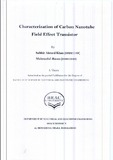| dc.contributor.advisor | Mominuzzaman, Sharif Mohammad | |
| dc.contributor.author | Khan, Sabbir Ahmed | |
| dc.contributor.author | Hasan, Mahmudul | |
| dc.date.accessioned | 2013-04-22T07:29:50Z | |
| dc.date.available | 2013-04-22T07:29:50Z | |
| dc.date.copyright | 2012 | |
| dc.date.issued | 2012-09-04 | |
| dc.identifier.other | ID 09221159 | |
| dc.identifier.other | ID 09221040 | |
| dc.identifier.uri | http://hdl.handle.net/10361/2334 | |
| dc.description | This thesis report is submitted in partial fulfillment of the requirements for the degree of Bachelor of Science in Electrical and Electronic Engineering, 2012. | en_US |
| dc.description | Cataloged from PDF version of thesis report. | |
| dc.description | Includes bibliographical references (page 55). | |
| dc.description.abstract | From the concept of material science, any materials haying an individual structure And characteristics have their own limitations. Due to the call for technological advancement, silicon-based integrated circuits and the scaling of’ silicon MOSFET design faces highcomplications like tunneling effect, short channel effect, gate oxide thickness effect etc. To solve these problems, new material alternatives are needed with such characteristics.
Recently, carbon nanotube has caught the attentions with promising future to replace
silicon-based materials due to its superior electrical properties and characteristics. Simulation
studies of carbon nanotube field-effect transistors ((CNFETs) are presented using models of
increasing rigor and versatility that have been systematically developed. The studies and
modeling of carbon nanotube, which includes band structures and current-voltage graphical
plots, are covered in this thesis Also, analysis has been made to see the effect of gate oxide
thickness change, temperature change, dielectric constant change, gate control coefficient, drain
control coefficient and chirality changing effect on the device performance, in particular on the
drain current.
"The purpose of this paper is to study the behavior of CNFET and the twain focus is on
the simulation of its current.-voltage (I-V) characteristic and observes the parameter changing
effect on it. The simulation study is carried out using MATLAB program and the result
obtained is used to compare the device performance with MOSFET. Resides, further analysis
has been done through the comparison of' the simulation result of the other groups to justify '
result. | en_US |
| dc.description.statementofresponsibility | Sabbir Ahmed Khan | |
| dc.description.statementofresponsibility | Mahmudul Hasan | |
| dc.format.extent | 55 pages | |
| dc.language.iso | en | en_US |
| dc.publisher | BRAC University | en_US |
| dc.rights | BRAC University thesis are protected by copyright. They may be viewed from this source for any purpose, but reproduction or distribution in any format is prohibited without written permission. | |
| dc.subject | Carbon Nanotube | en_US |
| dc.subject | Electrical and electronic engineering | |
| dc.title | Characterization of Carbon Nanotube field effect transistor | en_US |
| dc.type | Thesis | en_US |
| dc.contributor.department | Department of Electrical and Electronic Engineering, BRAC University | |
| dc.description.degree | B. Electrical and Electronic Engineering | |

